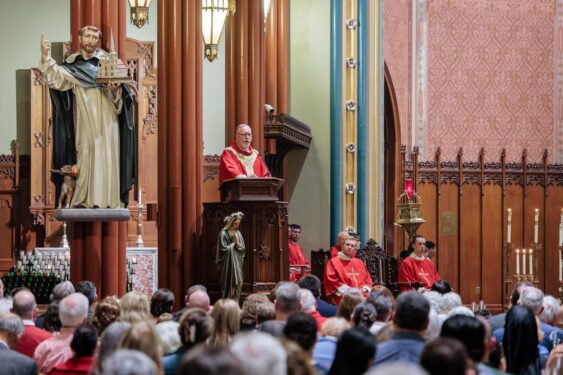
PROSPECT HEIGHTS — At one point of a May 18 Eucharistic procession in New Haven, Connecticut, amid a light rain, Archbishop Christopher Coyne of Hartford said he remembers pausing, turning around, and witnessing a great parade of 600-700 people behind him.
“It was very, very impressive,” Archbishop Coyne told The Tablet.
That procession and the Pentecost Vigil Mass earlier that day kicked off the National Eucharistic Pilgrimage St. Elizabeth Ann Seton Route, in which five perpetual pilgrims will travel about 6,500 miles from New Haven to Indianapolis for the National Eucharistic Congress.
The pews of St. Mary Church in New Haven, where the Pentecost Vigil Mass was celebrated, was packed with hundreds of Archdiocese of Hartford Catholics, many of whom participated in the procession thereafter. The procession traveled from the church to another in New Haven, St. Joseph Church.
From there, on May 19 the pilgrims processed to the Long Wharf section of New Haven to board a boat headed for the Diocese of Bridgeport. The pilgrimage continues through the Diocese of Bridgeport to the Archdiocese of New York and the Diocese of Brooklyn. Along the way to Indianapolis the pilgrims will also pass through Catholic dioceses in New Jersey, Pennsylvania, Maryland, and Ohio.
Archbishop Coyne said the archdiocese is honored to have served as the kickoff point for the eastern arm of the National Eucharistic Pilgrimage to Indianapolis, calling the weekend’s events a “wonderful celebration of the whole community in the Archdiocese of Hartford.”
Archbishop Coyne said the experience of the pilgrimage captures the spirit of the National Eucharistic Revival.
“The great event of the pilgrimage itself, and the opportunity for people to participate in it across the state of Connecticut and then into New York is really the best in terms of what the whole thing is about, which is a pilgrimage in spirit, in prayer with the Blessed Sacrament into various churches for the celebration of the Mass and moving forward and have people experiencing that along the way,” Archbishop Coyne said.
The U.S. bishops’ three-year National Eucharistic Revival initiative launched back in 2022, and is billed by those who organized it as “critical to rekindling a living faith in the hearts of Catholics across America” and “unleashing a new missionary chapter at this pivotal moment in Church history.”
The initiative started at the diocesan level, before moving to the parish level over the past year. The National Eucharistic Pilgrimage — of which there are a total of four 6,500-mile routes spread out throughout the country led by different perpetual pilgrims — and the National Eucharistic Congress are intended to launch the initiative into its final year, dubbed a “year of missionary sending.”
Archbishop Coyne said follow-through after the National Eucharistic Congress is essential for the revival initiative to succeed. He said the revival will only work if the congress doesn’t become a moment of closure or ending to the initiative, but a moment of beginning for a new missionary zeal in the United States.
“I don’t see the revival as an end in itself,” Archbishop Coyne said. “It’s a wonderful gathering in July, but it’s going to work post-revival if we see it as a Eucharistic Pentecost moment in which we come together in Indianapolis and we’re lit with the fire of the love of the Eucharist, of the love of the Church, in the power of the Holy Spirit, and we leave and then try to intentionally move forward in spreading the good news.”
Archbishop Coyne also noted that the revival initiative serves a shift in the American Church that he’s already begun to see take shape in the Archdiocese of Hartford, that is, a shift from Catholicism in the cultural sense — the faith connected with a person’s culture, neighborhood, etc. — to a Catholicism focused on discipleship.
“We have real intentional disciples in our churches now, and they firmly believe in the teaching of the Church and they firmly believe in what we hold dear as Catholics and what we need to do within our society in terms of offering them salvation and teaching, and they’re strong in that,” Archbishop Coyne said.
Archbishop Coyne added that as that call to discipleship becomes stronger and stronger, potentially inspiring more people to join the Church for the first time, or come back to the Church after a long absence, it’ll be important to make sure those people have a quality Mass to participate in. In that sense, he said the National Eucharistic Revival is also a call for the archdiocese to reinvigorate the Sunday Mass.
“I also see this as a call for us to revive the celebration of Sunday Mass in my parishes here in Hartford in terms of good, quality, celebration involving good presiding, good preaching, good music,” Archbishop Coyne said.
“And if people are going to come back to our churches we better make sure they come back to something that nourishes them, something that’s done with dignity and devotion.”
